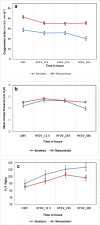Outcomes of Severe PARDS on High-Frequency Oscillatory Ventilation - A Single Centre Experience
- PMID: 31925715
- PMCID: PMC7222899
- DOI: 10.1007/s12098-019-03134-9
Outcomes of Severe PARDS on High-Frequency Oscillatory Ventilation - A Single Centre Experience
Abstract
Objective: To describe experience with high-frequency oscillatory ventilation (HFOV) in children with acute respiratory distress syndrome (ARDS) transitioned from conventional mechanical ventilation (CMV) due to refractory hypoxemia and to assess factors associated with survival and also compare outcomes of patients who were managed with early HFOV (within 24 h of intubation) vs. late HFOV.
Methods: This retrospective, observational study was conducted in a tertiary care hospital's pediatric intensive care unit. Thirty-four children with pediatric acute respiratory distress syndrome (PARDS) managed with HFOV were included.
Results: Of 34 children with PARDS managed with HFOV after failure of conventional ventilation to improve oxygenation, 8 survived. Improvement in the Oxygenation Index (OI) at 48 h of initiation of HFOV along with percent increase in PaO2/FiO2 (P/F ratio) at 24 h of HFOV were predictors of survival. The response to HFOV, based on OI and P/F ratio, between 24 and 48 h of ventilation identified potential survivors. Also, lower positive end-expiratory pressure (PEEP) on CMV and shorter duration of CMV before initiation of HFOV were associated with survival.
Conclusions: Survival in pediatric ARDS patients treated with HFOV could be predicted by using trends of OI - with survivors showing a more rapid decline in OI between 24 and 48 h of initiation compared to non-survivors.
Keywords: Conventional mechanical ventilation; High-frequency oscillatory ventilation; Pediatric ARDS.
Conflict of interest statement
None.
Figures

Comment in
-
HFOV in Pediatric ARDS: Viable or Vestigial?Indian J Pediatr. 2020 Mar;87(3):171-172. doi: 10.1007/s12098-020-03215-0. Epub 2020 Feb 5. Indian J Pediatr. 2020. PMID: 32026303 No abstract available.
References
-
- Arnold JH, Hanson JH, Toro-Figuero LO, Gutiérrez J, Berens RJ, Anglin DL. Prospective, randomized comparison of high-frequency oscillatory ventilation and conventional mechanical ventilation in pediatric respiratory failure. Crit Care Med. 1994;22:1530–1539. doi: 10.1097/00003246-199422100-00006. - DOI - PubMed
MeSH terms
LinkOut - more resources
Full Text Sources

